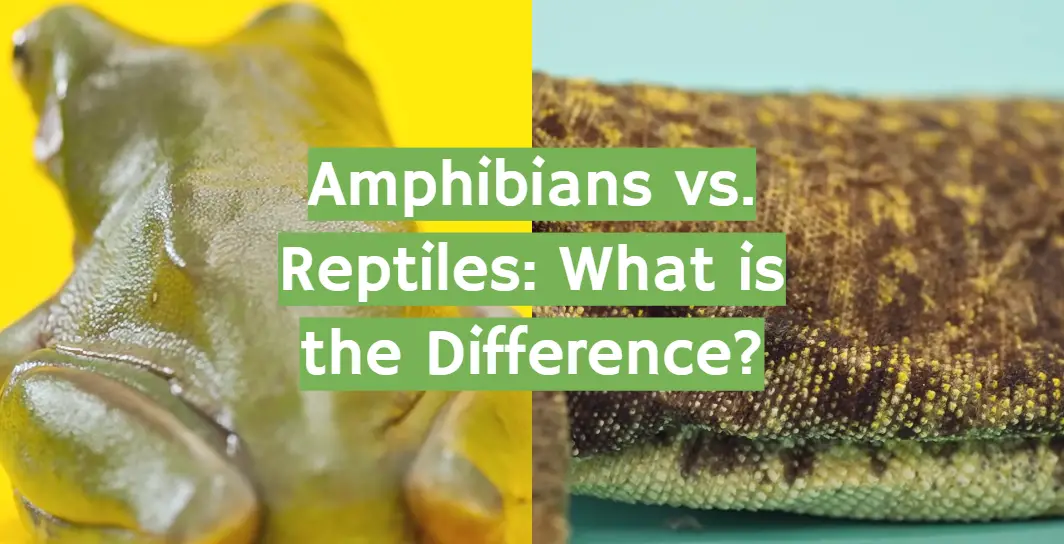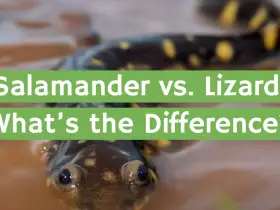When you think of animals, what do you think of? Dogs, cats, fish? These are all examples of animals found in the animal kingdom. There are also two other parts to this – amphibians and reptiles. Amphibians are cold-blooded creatures. Reptiles have scales on their skin and lay eggs rather than giving birth to live young.
The difference between amphibians and reptiles is one of the most common types of animal classification. Amphibians are a type of vertebrate that spend part or all of their lives in a moist environment, such as water or damp earth, while reptiles live their entire lives on land. This article discusses how they differ from each other and what makes them unique!
Amphibians Definition
Amphibians have a backbone and other vertebrae. They also lay eggs in water or a moist environment, while reptiles do not!
Amphibians have smooth moist skin. This skin contains mucous glands that secrete a fluid that is used to move through their environment.
An important distinguishing trait among amphibians is they are able to breathe through both lungs as well as with gills (some species).
Amphibians usually have four legs. However, some do not depend on what stage they are currently in during their lifetime.
Amphibians range from animals such as salamanders, newts, frogs, caecilians (worm-like limbless creatures), and sirens.
Reptiles Definition
Reptiles are cold-blooded as well as amphibians. They also have scales, lay eggs on land, and usually breathe using their lungs! Reptiles spend most of their time in the water or laying by a body of it.
Reptile’s backbones are made up of osteoderms that allow them to protect themselves from predators with their “shell”.
Reptiles lay eggs on dry land or in a nest they build. Scales rather than smooth moist skin like amphibians cover their outer layer.
Snakes, turtles, and lizards fall under this category!
The difference between reptiles and amphibians can be confusing because some kinds of snakes reproduce by laying eggs while others give birth to live young! It all depends on the species you’re referring to. Some reptiles even change colors on what environment it lives in.
Similarities
Many people mistakenly believe that the only difference between reptiles and amphibians is their ability to live on land or in water. While this is certainly true, it’s not the only thing that makes these two types of animals unique from one another; there are many differences between them even when they do share some commonalities.
On the other hand, there are many similarities between amphibians and reptiles, with some traits being more prevalent in one group than the other is.
For example, they both have dry scaly skin that helps protect them from predators.
Amphibian and reptile eggs also tend to be very similar. However, since most reptiles spend a great deal of time on land while amphibians mostly live underwater it’s easier for us to see this difference when we compare surface-dwelling reptiles to water-dwelling amphibians.
The same thing can usually be said about their reproductive organs too since male frogs and toads often carry around an extra appendage known as a nuptial pad which is used to help them grip on to the female during mating. This isn’t so common in reptiles, however, since they don’t have a need for this adaptation when most of their time is spent living on land.
Key Differences (Amphibians vs Reptiles)
Basis for Comparison
Amphibians and reptiles are both cold-blooded vertebrates, meaning they have a backbone and internal organ systems.
Differences between amphibians and reptiles that separate them:
Reproductive system
The primary difference between amphibians and reptiles lies in their reproductive strategies. Most types of fishes reproduce externally by spawning eggs into the water where fertilization takes place outside of the body.
Amphibian eggs develop either on land or in water depending upon species. However, all amphibian babies hatch from eggs in an aquatic environment before moving onto dry land as adults after metamorphosis (this process is called metamorphosis).
Reptiles, on the other hand, reproduce by laying eggs that hatch into live young. Reptiles are also known to lay eggs in small clutches, unlike the larger masses of fertilized fish eggs.
Skin
Amphibians have smooth skin that is permeable to water and covered with mucus whereas reptiles typically have scaly skin made up of a material called keratin that serves as protection against injury or illness by providing an armor-like exterior.
Amphibians tend to be more vulnerable than other animals because their thin delicate skins make them prey for many predators such as birds and other vertebrates.
Therefore, amphibian survival depends upon their ability to escape from danger quickly through camouflage (camouflage) or quick reproduction rates (short life spans). Reptiles do not rely on camouflage like amphibians but rather spend most of their time hiding in underground burrows or water-dwelling crevices (hibernation).
Body temperature
Amphibians are cold-blooded like reptiles but amphibian’s body temperatures fluctuate depending upon the environment whereas reptile bodies maintain a constant internal temperature. Most amphibians live on land, that is unless they undergo metamorphosis to become adult frogs and other types of aquatic animals; however, all reptiles spend their time living on dry land because their skin dries out quickly if submerged underwater for any length of time.
How do they breathe and feel?
Amphibians typically breathe through both lungs and skin while most reptiles rely solely upon lungs with supplemental breathing taking place through specialized sacs located behind the tongue called cloacal bursae. Unlike frog tongues which aid in catching prey, reptile tongues aid primarily in smell.
Lifecycle
Amphibians typically have shorter lifespans than reptiles. Amphibian metamorphosis occurs gradually over a period of weeks or months, whereas reptile babies hatch from eggs into miniature versions of adults (called neonates). On average, amphibians live about 70 years, while the lifespan of reptiles lasts from 50 to 200 years, depending on the species.
Amphibians lay their eggs in water, while reptiles either bury theirs or incubate them inside the female’s body. The length of time that it takes an egg to develop into a juvenile frog depends on the environment and species; some amphibian babies can be fully developed within two months, whereas others may take up to three years.
Reptile eggs typically hatch after 60-90 days (most likely because they are laid outside), but there are exceptions: leatherback turtles lay their nests in warm sand even though development is slowed down when temperatures decrease below 86F, so nest incubation usually lasts between four and five months depending on location. Once hatched, baby turtles immediately crawl towards the sea where they will spend most of their lives.
FAQ
What is unique about reptiles?
Reptiles are ectothermic, meaning they do not regulate their own body temperature. They rely on the sun’s warmth to heat up and cool down. This is why you see them hiding under rocks or logs during the day and hunting for food at night when it is cooler outside.
Reptiles can’t survive in very cold temperatures because of this lack of insulation. If reptiles overheat, its shell will dry out causing damage to their outer skin layer which can result in death. But don’t worry! Their scales act as armor against predators by covering most of their bodies with protection.
As mentioned earlier, snakes shed their skins periodically throughout development. Outward appearance may also change depending on environmental factors such as availability to water source and time of year.
Reptiles have a three-chambered heart. The right side pumps blood to the lungs, and the left side circulates it throughout the body.
Reptile eggs are also unique in that they do not contain water within them like amphibians’ eggs do that allows embryos to live without being attached to a body of water for development. Because reptiles lay their eggs on land, there are specific environmental conditions that must be met, or else offspring will die before hatching (moisture levels need to remain consistent, etc.).
What is unique about amphibians?
Amphibians typically can breathe through their skin, which makes them very sensitive to changes in the environment like pollution or chemicals that are dumped into waterways.
Amphibians are cold-blooded so they must live in an environment with the right temperature to survive.
Their skin is very porous, which makes them sensitive to changes in their surroundings and particularly vulnerable to chemicals that may pollute waterways where they reproduce.
They also need water for reproduction. With a few exceptions like lungfish or desert-dwelling frogs, all amphibians breathe through their skin (which is why you’ll find many of them living near streams).
As cold-blooded animals, they rely on external sources of heat. If it’s too hot out or if there isn’t enough cover from the sun, they either die or slow down drastically. It should come as no surprise that amphibians tend to be very sensitive to environmental changes, particularly in their habitats.
What makes amphibians different from reptiles?
Amphibians include frogs, toads, and salamanders while reptiles cover a vast array of animal species including lizards, snakes, and turtles. These are just some of the many differences that make amphibians and reptiles unique species:
- Amphibians have moist skin that is needed for their young to live on land;
- Reptiles tend to be a bit larger than amphibians and also have scales that help protect them from the sun’s radiation;
- Amphibians are more sensitive to temperature changes, whereas reptiles can take hot or cold temperatures better;
- The life span of an amphibian is typically shorter than a reptile as well. Even though there are many differences between these two creatures, they both play important roles in our ecosystem;
Are all amphibians reptiles?
Not all amphibians are reptiles. Mammals, birds, fish, and other animals that live both in water and on land are not classified as amphibians or reptiles.
Amphibians include frogs/toads, salamanders (including newts), caecilians (worm-like legless burrowing amphibians).
Reptiles can be snakes, turtles lizards, crocodiles /alligators. However, there is often overlap between the groups with some species being able to switch back and forth from aquatic habitats to terrestrial ones.
Why is a crocodile a reptile and not an amphibian?
Crocodilians are reptiles and not amphibians. For one, crocodiles lack an aquatic larval stage in their development that is a common trait of most amphibian species.
Additionally, the eggs that they lay on land often have tough leathery shells to keep them from drying out.
And throughout life, crocodilians breathe air through lungs rather than through gills like tadpoles and frogs do when young and adults can be observed breathing by rising up onto their toes with mouths open every so often taking gulps of air while waiting for prey or after exerting themselves during mating season. Also unlike all other modern amphibians, crocodiles lay exposed nests consisting simply of piles of sand without any coverings such as aquatic plants.
Can a reptile be amphibious?
Can a reptile be amphibious? No, because reptiles are not always cold-blooded. Reptiles have been around for millions of years and can adapt to many different habitats. They enjoy living in the desert or near the ocean where they can bask in the warm sun on hot days and stay cool during chilly nights. Reptiles can’t survive in cold climates.
Reptiles are cold-blooded, meaning the surrounding environment determines their body temperature. They can’t regulate their body heat and need to depend on sun-basking or burrowing underground in order to keep warm.
Reptiles such as lizards and turtles can spend long periods underwater because they have lungs that allow them to breathe oxygen from air; however, these reptiles must immediately return to dry land after a heavy rainstorm for this reason.
Amphibians like frogs do not require lungs but rather skin which allows them to absorb oxygen through diffusion with water.
Do amphibians have lungs?
Most amphibians, including frogs and toads, breathe through their lungs and skin. The majority of the oxygen they consume is absorbed directly through their skin on occasion. Tadpoles and certain aquatic amphibians have gills similar to those of fish that they use to respire.
Is an amphibian a reptile or mammal?
Amphibians are cold-blooded, meaning their internal body temperature varies with the environments they live in.
Amphibians must rely on external means to control their body temperatures. This makes them very sensitive to changes in environmental conditions and easily threatened by changing climates or habitats.
Amphibians have a lower metabolic rate than mammals. They breathe with lungs, but also through their skin and lining of the mouth, that is why they need moist environments to live in. Amphibian skins are porous allowing for some gas exchange as well as waste removal from the body. This makes them very sensitive to pollutants or toxins in water sources where they reside because it can quickly build up on their skin and suffocate them.
Reptiles do not rely on external means to control the temperature as amphibians do. Reptiles’ internal temperatures remain largely unchanged regardless of environmental conditions outside of their bodies, meaning they require an animal that has a high body temperature to maintain its internal warmth and requires less food energy per unit weight compared to other animals. Reptiles are ectothermic, meaning they rely on external factors like the sun or their surrounding temperatures for heat and energy.
Reptile skin is dry but still porous allowing for gas exchange as well as waste removal from the body just as amphibians do. This makes them vulnerable in certain environments where pollutants or toxins may be present similar to how amphibians would become affected by these conditions too.
Their scales give reptiles protection against insects’ bites since it offers an additional layer of defense that other skin types don’t provide while also helping regulate their bodies’ temperature because this outer shell covers a significant portion of the reptilian body surface area giving off more heat than what would escape through un-scaled skin.
Can reptiles live in both land and water?
Many reptiles can live on land and reproduce in dry regions. Some reptiles (such as sea turtles) are adapted to living in water, although even these species come onto land to lay their eggs. Reptiles may be found in a variety of habitats, but they are most common in warm, tropical climates.
One of the main differences between reptiles and amphibians is that they live in different habitats. Reptiles generally spend their lives on land, while amphibians spend most of their time living in water or at least near a body of water. For this reason, most reptiles have dry scaly skin to protect them from drying out when it’s hot outside. Amphibian skin helps them absorb moisture so they can stay wet for lengthy periods without drowning.






Leave a Review